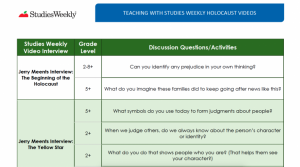Guidelines for Teaching the Holocaust with Studies Weekly
Holocaust education is the story of people. Each number, statistic, chart, or list depicts an individual — someone’s son or daughter.
According to the United States Holocaust Memorial Museum, those who teach about the Holocaust must “seek to honestly and accurately investigate a history in which millions of people were dehumanized, brutalized and killed while ensuring a safe classroom environment in which their students can engage in learning and critical thinking.”
It is not an easy story to tell. And often it spurs complex questions that have no easy answers. Thus, the Holocaust is a topic that must be taught with compassion and empathy.
International Holocaust Remembrance Day is Jan. 27, and can be a perfect time for lessons on tolerance, inclusion, anti-bullying, building communities, and service. (Please note that the United States Holocaust Memorial Museum does not recommend teaching the Holocaust before 6th grade.)
Some states, like Texas, have designated entire weeks to remembering the Holocaust. The Texas Holocaust and Genocide Commission designated Jan. 27-31 as Holocaust Remembrance Week, and encouraged schools across the state to incorporate grade-level instruction within their curriculum. Their site has many resources, guidelines and activities.
If this era of history is part of your instruction, here are some guidelines, pulled from the United States Memorial Museum, the Commonwealth of Pennsylvania, and the Texas Holocaust and Genocide Commission:
Understand the Definition of the Holocaust
Teachers and students need to understand exactly what the term “Holocaust” is and is not. Our blog post on this topic shares some valuable background information to get you started.
Focus on Primary Sources
This topic must be connected to the human experience, and the best way to do this is through primary sources and sound historical research from respected resources.
Studies Weekly has multiple videos of Holocaust survivors telling their own stories. As your students listen to first-hand accounts, they can develop the capacity to make choices concerning their own beliefs, and how their actions in their world can stop or perpetuate bigotry.
 You can find many video interviews from Holocaust survivors when you login to Studies Weekly Online.
You can find many video interviews from Holocaust survivors when you login to Studies Weekly Online.
We’ve created grade-level discussion prompts to guide you and your students as you use these videos. You can find them here. ⇒
Teach with Respect
Holocaust instruction should always include compassion for the victims. Do not show photographs of non-living victims. While photos of dead bodies may catch students’ attention, this is not respectful. The person in the photo did not give permission for their image to be used in such a way. The victim was a mother, father, brother, or sister. Respect and honor their memory and their living family.
Avoid Generalities
Use resources and materials from legitimate, responsible venues that share a balanced, nuanced, and historically accurate perspective on the history. Each story deserves careful analysis, examination and reflection.
As explained by the USHMM guidelines, “The history of the Holocaust raises difficult questions about human behavior and the context within which individual decisions are made. Be wary of simplification.”
It is also important to remember that not all Jews’ experiences during this time were the same. Conversely, not all Germans were Nazis. Avoid stereotypes.
Focus on the People behind the Numbers
According to estimates, the Nazi Party murdered six million Jews and five million others. These numbers are hard for anyone to comprehend. Show your students the individuals behind the numbers — someone’s parent, child, or grandparent. Again, first-person accounts from those who survived can help here.
Encourage Critical Thinking
USHMM encourages educators to avoid simulation exercises when teaching about the Holocaust, as it is “best to draw upon a variety of primary sources, provide survivor testimony, and refrain from simulations or games that lead to a trivialization of the subject matter.”
In addition, when planning instruction on the Holocaust, you should plan for enough time to have students express themselves in some manner. For many, this is their first introduction to the inhumanity of people. They will be shocked, confused, disillusioned, or a myriad of other emotions. Help them process and express what they are feeling through writing, talking, doing art, or taking a walk.
Present Age-Appropriate Content
In lower elementary grades, the conversation should center on tolerance for all people. Upper elementary and younger middle school students can focus on the small ways people inadvertently demonstrate bias and stereotyping through remarks or stories that are hurtful.
Overall, give students tools to help them learn to be kind and accepting of others. This attitude should extend past Holocaust Remembrance Week. Kindness, tolerance, inclusion and respect are timeless traits that if internalized, can safeguard us all from repeating the atrocities of history.
Additional Resources:
Echoes and Reflections: Teaching the Holocaust
